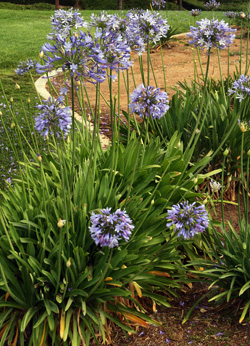Agapanthus Care Tips for Lush and Vibrant Flowers
Agapanthus Care Tips for Lush and Vibrant Flowers
Blog Article
Understanding the Art of Agapanthus Care: Important Actions for Healthy And Balanced Development and Dynamic Flowers
In the realm of horticulture, the farming of agapanthus stands as a fulfilling venture for those that seek to support these elegant flowering plants. From selecting the right range to mastering trimming methods, the trip in the direction of cultivating thriving agapanthus plants is multifaceted and holds the crucial to unlocking the complete possibility of these botanical treasures.

Selecting the Right Agapanthus Variety

When choosing the best Agapanthus variety for your garden, consider variables such as environment viability, blossom color, and growth practice. In addition, consider the climate in your region to make sure the Agapanthus selection you pick can thrive in your certain problems. Comprehending the development routine of different Agapanthus ranges is crucial for appropriate placement within your garden.
Perfect Growing Conditions
Taking into consideration the ideal ecological needs is necessary for successful Agapanthus growing. Agapanthus thrives in well-draining dirt with a slightly acidic to neutral pH level. When planting, select a place that receives complete sunshine to partial shade. In hotter climates, giving some afternoon color can stop scorching of the leaves. Agapanthus plants are delicate to cool temperatures and should be safeguarded from frost throughout cold weather.
To make certain healthy and balanced growth and vibrant blossoms, plant Agapanthus light bulbs at a depth of about 2-4 inches and room them 8-12 inches apart. Including natural issue, such as compost, to the soil can enhance drainage and fertility, advertising robust root advancement. Mulching around the base of the plants assists preserve dampness and reduces weed growth. Routine watering is essential, especially during the growing season, to maintain the dirt constantly wet but not saturated.
Watering and Fertilizing Tips
Preserving proper dampness levels and providing essential nutrients are crucial elements in the treatment regimen for Agapanthus plants. It is vital to strike an equilibrium when it comes to sprinkling Agapanthus. If overwatered, these plants like regularly moist soil but are at risk to root rot. Throughout the expanding season, water deeply as soon as a week, ensuring the dirt is well-draining to avoid waterlogging. In hotter environments or during durations of drought, even more regular watering may be essential to keep the soil evenly wet. Nonetheless, lower watering in the winter months to stop water logged problems.
Feeding Agapanthus is essential for promoting healthy growth and respected blooms. Use a balanced fertilizer, such as a 10-10-10 formula, in the early springtime as brand-new development emerges. Repeat this application every 6-8 weeks throughout the expanding period. Prevent too much fertilizing, as it can result in lush vegetation at the cost of blossoms. Always comply with the supplier's directions for correct dilution and application approaches. By complying with these watering and feeding visit our website suggestions, you can ensure your Agapanthus plants flourish and create lively, long-lasting blossoms. go now
Trimming Techniques for Agapanthus
Trimming Agapanthus plants at the ideal times and with appropriate techniques is vital for keeping their health and wellness and advertising optimal growth and blooming. The ideal time to prune Agapanthus is in late winter or very early springtime prior to new growth arises.
Deadheading spent blossoms can likewise redirect the plant's power right into generating even more blossoms instead than establishing seeds. If you desire to accumulate seeds for propagation, leave some flowers to mature and dry on the plant.
Remember to use tidy, sharp devices to make exact cuts and minimize the danger of presenting conditions. Agapanthus. Routine pruning will certainly assist maintain your Agapanthus looking cool and healthy and balanced while making certain a plentiful display of attractive flowers
Managing Common Parasites and Diseases
After ensuring appropriate pruning techniques for Agapanthus, it is necessary to attend to usual parasites and illness that can affect the health and wellness and vigor of these plants. One common parasite that influences Agapanthus is the Agapanthus gall midget.
Additionally, Agapanthus plants can suffer from root rot if they are grown in inadequately draining soil. By being cautious and taking prompt activity versus pests and diseases, you can help your Agapanthus plants thrive and produce lively blossoms. Agapanthus.

Verdict
In conclusion, mastering the art of agapanthus treatment entails picking the best variety, giving optimal growing conditions, correct watering and feeding, proper pruning strategies, and dealing with usual pests and illness. By adhering to these necessary actions, you can make certain healthy and balanced growth and lively flowers for your agapanthus plants. Keep in mind to consistently monitor and preserve your plants to promote their overall wellness and longevity.
To make certain healthy and balanced growth and lively blooms, plant Agapanthus bulbs at a deepness of concerning 2-4 inches and area them 8-12 inches apart. By adhering to these watering and feeding tips, you can ensure your Agapanthus plants grow and generate lively, long-lasting blooms.
One common insect that affects Agapanthus is the Agapanthus gall midge. In addition, Agapanthus plants can endure from origin rot if they helpful hints are planted in poorly draining dirt. By complying with these vital steps, you can make sure healthy growth and dynamic flowers for your agapanthus plants.
Report this page